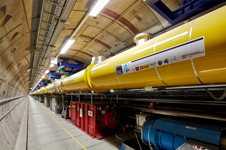 |
Date Announced: 23 Aug 2017
Pictured, right: the European XFEL accelerator tunnel. (Credit: European XFEL)
Swindon, UK – One of the world’s fastest detectors, capable of capturing images in billionths of a second, has been developed by the UK for use at the world’s largest X-ray laser, the European XFEL.
The Large Pixel Detector (LPD) is the first advanced detector to be installed at the European XFEL in Hamburg, Germany. The LPD is a cutting-edge X-ray camera developed at the Science and Technology Facilities Council’s (STFC) Rutherford Appleton Laboratory near Oxford.
Dr Brian Bowsher, Chief Executive of STFC, said: “This is a significant milestone for the European XFEL and we are delighted to make such an important contribution to the project.
“International collaborations are key to developing these state-of-the-art facilities and this work reinforces the international role STFC and the UK has in science.
“It’s an extremely exciting time for the XFEL facility, and I am looking forward to seeing the first experiments taking place.”
The LPD is the first fully functional X-ray light detector to record at a rate of 4.5 MHz—4.5 million pictures per second, fast enough to keep up with the European XFEL’s high repetition rate of 27,000 pulses per second, which are arranged into short bursts. The LPD will allow users to take clear snapshots of ultrafast processes such as chemical reactions as they take place.
STFC’s Matthew Hart, the lead engineer who has worked on the LPD since 2007, said: “It’s such a great feeling to see the detector installed ready for experiments. It’s taken 10 years of development to meet some really challenging requirements and finally the day has arrived to see it working for real.
“It was made possible thanks to the world class engineering team we have at STFC’s Rutherford lab in the UK, huge credit goes to them for their hard work and commitment over such a long and difficult project. Now the detector is in the hands of the scientists at XFEL I’m really looking forward to hearing about their research and discoveries they will make.”
The LPD operates far beyond the scope of any commercial detector or camera. Its design enables the detector to capture an image every 222 nanoseconds (billionths of a second)—an unprecedented rate that allows it to capture individual ultrashort X-ray laser flashes from the European XFEL. Additionally, the detector has a very high so-called dynamic range, meaning it can pick up signals as weak as a single particle of light, also known as a photon, and as strong as a flash of several tens of thousands of photons in two neighbouring pixels.
In a typical experiment at the European XFEL, users will place samples in the path of incoming X-ray laser pulses in order to study their structure at the atomic level. Detectors will pick up the X-ray laser light scattering off of the sample, which often consists of individual molecules. The LPD’s high dynamic range allows for very high resolutions showing the finest details from samples.
European XFEL Detector Development group leader Markus Kuster said: “The years of intensive collaboration with STFC’s Rutherford Appleton Laboratory on the LPD have paid off, and resulted in a unique detector that can record data on the timescale of a billionth of a second.”
E-mail: allen.orville@diamond.ac.uk
Web Site: www.diamond.ac.uk
| © 2025 SPIE Europe |
|